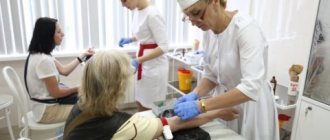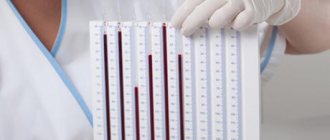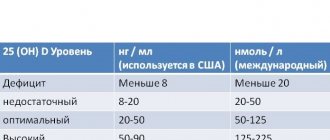Glucose (sugar) is an important component of metabolic processes occurring in the bodies of women, men and children. It provides all cells and tissues with the necessary amount of energy for normal life. Glycemic indicators do not depend on gender, which cannot be said about the age of people. The older a person is, the higher the numbers are considered acceptable blood sugar levels.
A woman’s body goes through different stages of development during her life: childhood, puberty, pregnancy, menopause, old age. Each period has its own characteristics, hormonal balance, functional state of organs and systems. This also applies to blood sugar. Next, we consider the norm of blood sugar in women by age, methods of controlling glycemia, and manifestations of changes in indicators up and down.
Table of sugar norms for venous blood and finger blood (capillary)
| Blood on an empty stomach | Norm | Pre diabetes | Diabetes |
| From the finger | 3.3–5.5 mmol/l | 5.5–6.0 mmol/l | 6.1 mmol/l |
| From Vienna | up to 6.1 mmol/l | if above 7.0 mmol/l |
The normal blood sugar level for women is in the range of 3.0 – 5.5 mmol/l. Incorrect blood donation can lead to distorted test results. The level of content in an ordinary healthy person can fluctuate within 5 mmol/l.
A woman's sugar level can be influenced by various reasons, such as the woman's age, her weight, excess weight and what she eats: more vegetables and fruits or cakes, sweets, sweet pastries.
Excess weight has the most significant effect on blood glucose levels, which applies equally to both the fair sex and men.
In overweight people, glucose levels are often higher than average.
Causes of high blood sugar levels:
- abuse of sweet foods with large amounts of easily digestible carbohydrates;
- decreased physical activity or sedentary lifestyle, alcohol abuse;
- frequent stress and breakdowns and bad mood;
Sugar levels also change in women during the menstrual cycle and after its cessation during menopause. Pregnancy also affects.
| Sugar norm | ||
| hypoglycemia | norm is less than 3.3 mmol/l | |
| norm | on an empty stomach 3.3-3.5 | normal after meals up to 7.8 |
| hyperglycemia | fasting norm is more than 5.5 | after eating more than 7.8 |
The unit of measurement for this blood parameter is millimoles per 1 liter of blood (mmol/l). An alternative unit is milligram per deciliter of blood mg/100 ml (mg/dL). For reference: 1 mmol/l corresponds to 18 mg/dl.
Indications
A biochemical blood test for sugar is recommended to be done once every 3 years for patients over 40 years of age and once a year for those who are at risk (heredity for diabetes mellitus, obesity, etc.). This will help prevent the development of life-threatening diseases and their complications.
- Preventive examination of patients at risk for diabetes mellitus;
- Diseases of the pituitary gland, thyroid gland, liver, adrenal glands;
- Monitoring the condition of patients with type 1 and type 2 diabetes mellitus receiving treatment, together with analysis for glycated hemoglobin and C-peptide;
- Suspicion of the development of gestational diabetes (24-28 weeks of pregnancy);
- Obesity;
- Prediabetes (impaired glucose tolerance).
Also, an indication for analysis is a combination of symptoms:
- strong thirst;
- frequent urge to urinate;
- rapid weight gain/loss;
- increased appetite;
- increased sweating (hyperhidrosis);
- general weakness and dizziness, loss of consciousness;
- smell of acetone from the mouth;
- increased heart rate (tachycardia);
- visual impairment;
- increased susceptibility to infections.
Risk groups for diabetes:
- Age from 40 years;
- Overweight; (abdominal obesity)
- Genetic predisposition to diabetes.
An endocrinologist, gastroenterologist, therapist, surgeon, pediatrician and other specialized specialists or general practitioners can interpret the results of a blood sugar test.
Sugar levels for women by age in the table
, the blood sugar level in women after 50 or 60 years of age may change due to hormonal changes in the body, as well as other endocrine diseases.
Sugar levels for women by age, table:
| age | norm mmol/l | |
| Infants | 2 days - 4.3 weeks | 2.8-4.4 mmol/l |
| Children | 4.3 weeks - 14 years | 3,3 — 5,6 |
| Teenagers and adult women | 14 – 60 years | 4,1 — 5,9 |
| Older women | 60 - 90 years | 4,6 — 6,4 |
| Old timers | over 90 years old | 4,2 — 6,7 |
Preparing for the test
Blood sugar levels can be determined by laboratory blood testing (capillary or venous).
Here are some tips to help avoid inaccurate indicators:
- Blood sampling is carried out only on an empty stomach and in the morning. Approximately 10 hours should have passed since the last meal;
- On the eve of the analysis, you should not change your usual diet, as this may provoke false indicators;
- Try to avoid stress, don’t get nervous;
- The day before the test, you should stop drinking alcohol;
- Avoid sports 1–2 days before blood sampling, as otherwise the indicators may be significantly reduced;
- Sleep well;
- Do not brush your teeth in the morning, as toothpastes also contain sugar.
You can determine your glucose level yourself at home using a glucometer.
By taking a general blood test or using a glucometer, using tables of glucose norms for women of different ages in this article, you can easily determine whether your readings are within the normal range. Otherwise, you must contact an appropriate specialist.
Blood sugar in women aged 50
After 50 years (during menopause), a woman’s glucose level gradually increases. This is usually associated with the onset of menopause, which leads to changes in hormonal levels.
During this period, you need to be especially careful about your health, monitor your sugar levels and, if necessary, lower them.
| blood type | age | glucose indicator, mmol/l |
| capillary | from 50 to 60 | 3,8–5,9 |
| venous | from 50 to 60 | 4,1–6,3 |
What is the normal blood sugar level for women over 60 years old, table
| Blood type | age | glucose indicator, mmol/l |
| capillary | from 50 to 60 | 3,8–5,9 |
| venous | from 50 to 60 | 4,1–6,3 |
According to the latest data conducted in medical institutions, the sugar level in women after 60 years of age increases. Therefore, women after 60 years of age need to correct test results. The correction is 0.056 mmol/l (1 mg/100 ml) for each subsequent year.
High blood sugar levels and high cholesterol are often diagnosed in women after 60 years of age.
In elderly people, the norm can be from 4.4 to 8.0 mmol/l (80-145 mg/100 ml) on an empty stomach, which is not considered a deviation from the norm. An excellent regulator of this parameter in women is sex hormones.
Changes in hormonal levels and elevated blood sugar require special attention. It is better to buy a glucometer for these purposes and regularly monitor your glucose levels.
The test should be carried out before meals on an empty stomach. A correctly performed analysis allows you to identify deviations from the norm and signs of diabetes in the early stages of the disease. If it is not urgent, it is better to do the analysis in the morning.
When measured a few hours after a meal, the sugar level may range from 4.1 to 8.2 mmol/liter, this is normal.
Keep in mind that the results of a blood test may be distorted if you have been on a diet for a long time, fasted, worked hard physically, took antihistamines, or drank alcohol.
Increased sugar levels symptoms
If you have symptoms of pancreatic disease, liver disease, thyroid gland, pituitary gland;
Frequent urination and continuous feeling of thirst, and strong appetite;
- Sometimes blurred vision;
- Frequent infections and thrush (candidiasis).
- There are signs of obesity
- Wounds do not heal well
- Pain and numbness in the legs
- Chronic weakness
- Frequent skin infections
Pay attention to this and consult a doctor; if this is confirmed by blood sugar tests, then there is a high probability that you have symptoms of diabetes. The doctor will prescribe you observation (monitoring) to identify what type of diabetes you may have, type 1 or type 2, whether it is a prediabetic condition or diabetes.
- See All symptoms of diabetes mellitus: types 1 and 2; distinction and diagnosis.
When is a blood sugar test prescribed?
First of all, people with diabetes mellitus donate blood for sugar to monitor their condition and the effectiveness of treatment, and secondly, they donate blood for the diagnosis of diabetes mellitus.
Those who have abnormalities in the functioning of the thyroid gland, adrenal glands, pituitary gland, patients with liver diseases, those who are overweight and pregnant women. People with impaired glucose tolerance. A blood sugar test remains the main test for diagnosing diabetes.
In women after 60 years of age, as well as after menopause, a woman’s blood sugar levels change. During this period, women are often diagnosed with diabetes.
Hyperglycemia - what is it?
An increase in sugar levels is called hyperglycemia, the reasons are:
- hyperglycemia is observed in diseases of the hormonal system: pheochromocytoma, thyrotoxicosis, acromegaly, gigantism, Cushing's syndrome, somatostatinoma,
- diseases of the pancreas: pancreatitis, as well as pancreatitis with mumps, cystic fibrosis, hemochromatosis, pancreatic tumors;
- Liver diseases
- Kidney diseases
- Cardiovascular diseases: stroke, heart attack,
- Taking medications based on: caffeine, estrogens, thiazides, glucocorticoids
- Antibodies to insulin receptors
- Stress, physical and emotional overload
- Smoking and alcohol abuse
- Adrenaline injections
- More than 40% of all patients whose sugar levels are high are diagnosed in one way or another with inflammation of the pancreas: pancreatitis,
What should you be wary of?
The main reasons for increased glucose levels are: diabetes, overeating, stress, and the presence of an infectious disease.
Elevated glucose levels are called hyperglycemia.
There are some signs that may indicate that your sugar levels have increased:
- dry mouth and thirst;
- skin itching;
- frequent urination;
- increased urine volume;
- the occurrence of night urination;
- headache and dizziness;
- noticeable weight loss;
- general weakness and fatigue;
- decreased vision;
- long wound healing;
- the occurrence of frequent infectious diseases.
Such symptoms should alert you and prompt you to visit a doctor. The diagnosis is made based on the results of appropriate tests.
Low blood sugar is called hypoglycemia.
The most common signs:
- headache;
- constant presence of hunger;
- dizziness;
- cardiopalmus;
- sweating;
- tearfulness;
- irritability;
- lack of mood.
Video about the causes and symptoms of diabetes:
Decreased sugar levels (hypoglycemia)
A decrease in the norm is called hypoglycemia. Reasons for this condition:
- malabsorption of nutrients (malabsorption syndrome), prolonged fasting,
- pancreatic diseases: insufficiency of alpha cells of the islets - glucagon deficiency, hyperplasia, adenoma or carcinoma, beta cells of the islets of Langerhans - insulinoma,
- liver diseases (cirrhosis, hepatitis, carcinoma, hemochromatosis),
- oncology: adrenal cancer, stomach cancer, fibrosarcoma,
- endocrine diseases: Addison's disease, adrenogenital syndrome, hypopituitarism, hypothyroidism,
- malignant non-pancreatic tumors: fermentopathy (glycogenosis - Gierke's disease, galactosemia,
- inheritance from mother
- overdose of insulin drugs (hypoglycemic drugs)
- poisoning with arsenic, chloroform, salicylates, antihistamines,
- alcohol poisoning,
- impaired fructose tolerance,
- febrile conditions
- taking anabolic steroids: propranolol, amphetamine
- physical exhaustion
What is the normal blood sugar level for pregnant women?
Pregnant women may experience elevated blood sugar levels in the early stages. Norm for a pregnant woman:
- on an empty stomach - 4-5.2 mmol/l
- 2 hours after eating – no more than 6.7 mmol/l.
Sugar levels in a pregnant woman may be lower than in women who are not pregnant. During this period, hormonal changes in the body and optimization of metabolism in pregnant women occur. Pregnant women need to donate blood on time and monitor glucose levels to prevent the development of gestational diabetes, which can develop into type 2 diabetes. This is due to a decrease in amino acid levels and an increase in ketone bodies.
When pregnancy proceeds normally, the release of insulin in the woman’s body increases during the second and third semester. This allows you to keep your sugar levels within normal limits during pregnancy.
It is not uncommon to be diagnosed with gestational diabetes, which can only be detected in the second trimester of pregnancy or after the birth of the baby.
The most important task of the doctor is to maintain glucose at the proper level for the normal development of the child. The frequency of diagnosis of gestational diabetes is no more than 3.5% of episodes. The risk of developing diabetes increases in the following cases:
- Bad heredity
- Pregnancy after 30 years
- Woman is overweight
- Polycystic disease appearing in the ovaries
To diagnose diabetes, all pregnant women at risk should undergo a glucose tolerance test between 24 weeks and 28 weeks. The test allows you to find out the level of glucose in the blood on an empty stomach and after 2 hours of the placenta. They can also check what your sugar level is after 1 hour of exercise.
It is best for women who are at risk and who are planning to have a child to consult a doctor in advance.
- What is the normal blood sugar level for pregnant women according to the new standards?
Blood glucose test
Glucose is an organic compound that is the main source of energy for the body's cells and the only one for the brain and nervous system. For the normal functioning of all organs and systems of the body, a relatively constant level of glucose must be maintained. During digestion, carbohydrate sources are broken down into glucose and other nutrients; they are absorbed by the small intestine and distributed throughout the body. The use of glucose for energy depends on insulin, which facilitates the transport of glucose into the body's cells and stimulates the liver to store excess energy as glycogen for storage.
Typically, blood glucose levels rise slightly after eating, and the pancreas responds by releasing insulin into the blood in an amount appropriate to the size and content of the meal. As glucose enters cells and is metabolized, blood levels drop and the pancreas responds by slowing and then stopping the release of insulin.
Causes of high blood sugar levels
The liver is responsible for maintaining a stable glucose level. Thus, if too many carbohydrates enter the body, then all the excess is deposited in the liver, and as much as necessary enters the blood. Glycogen, which contains carbohydrates in the liver, is the storage of carbohydrate reserves of the entire body.
For example, in the plant world, starch carries out such a mission. Glycogen is a polysaccharide, the granules of which enter the cytoplasm and are broken down into glucose (if there is not enough of it in the body). The main storage site for glycogen in the human body is the liver and muscles.
It is believed that a healthy person weighing around 70 kg should have a carbohydrate reserve of 325 grams, which is an approximate norm. Muscle glycogen is a source of energy for stable muscle function. Glycogen in the liver contributes to the concentration of glucose between meals. As time passes after eating (up to 18 hours), the glycogen accumulated by liver cells practically disappears. Muscle glycogen levels can be reduced by intense physical activity.
If a woman eats foods that contain starch, significant changes in the level in the blood composition, as a rule, do not occur. The reason for this phenomenon is that starch in the human body undergoes a long process of breakdown, which results in the formation of slowly absorbed monosaccharides.
Eating foods high in carbohydrates can cause a sharp rise in sugar levels (dietary (nutritional) hyperglycemia).
When its content reaches a level of 8.5-10 units, the kidneys become involved in the process of removing glucose from the body, as evidenced by the presence of sugar in the urine. This process is rapid and does not cause harm to health; this way the balance in the body and its normality are restored.
If problems arise with the function of the pancreas, then the norm in the blood is not met, increases and can reach 11.1. In this case, the presence of diabetes mellitus can be assumed.
Decreased glucose levels
Hypoglycemia (low glucose levels) in some cases without treatment can lead to the development of a serious condition.
With diabetes, glucose can not only increase, but also sharply decrease.
Causes of hypoglycemia in patients with diabetes mellitus:
- Exceeding the dosage of antidiabetic drugs and insulin;
- The presence in the diet of foods rich in simple carbohydrates in large quantities;
- Excessive physical activity;
- Drinking alcoholic beverages;
- Violation of water balance;
- If a person has not eaten for a long time, but is taking antidiabetic drugs.
It should be noted that hypoglycemia can also occur in a person who does not have diabetes. Other causes of low sugar:
- Excessive consumption of confectionery products;
- Violation of metabolic processes in the body;
- Glucose levels are reduced in the morning on an empty stomach, when more than 8 hours have passed since the last meal;
- Hypoglycemia can be a side effect of certain medications;
- Rare meals (up to 2 times a day);
- Increased physical activity;
- Excessive consumption of alcoholic beverages;
- Strict diets with the exclusion of carbohydrates;
- Diseases of the liver, kidneys or pancreas.
If hypoglycemia is associated with improper, infrequent nutrition, then it is recommended to switch to 4–5 meals a day and include foods rich in complex carbohydrates in the diet.
An attack of hypoglycemia with pronounced symptoms can be relieved by foods containing large amounts of simple sugars (sweets, sweet tea, waffles, jam, etc.).
Physical activity should be moderate and avoid overwork. It is recommended to take long walks daily.
How to lower blood sugar without drugs
When you are at risk of developing diabetes, eating a healthy diet is an effective way to lower your blood glucose levels.
This helps to avoid medications in the early stages, and in some cases, significantly reduce their use. There are special products sold in our retail chains that stabilize sugar levels.
#1 Consistently eat foods without starch.
Non-starchy foods include products such as
- Cucumbers;
- Carrot;
- Spinach;
- Broccoli;
For example, spinach is very helpful in preventing the development of type 2 diabetes due to its high content of magnesium. Studies have been conducted that have proven that consuming foods high in magnesium reduces the risk of developing diabetes by 10%.
#2 Eat nuts
Nuts: walnuts, almonds, pistachios reduce sugar levels as sources of low-saturated fats. This in turn does not lead to an increase in glucose levels like other products. The fat found in nuts affects cells, making them more sensitive to insulin. This helps control sugar levels.
#3 Eat more whole grains
Substances such as oat bran, rye, and barley are whole grains that are rich in fiber and contain beta-glucan. Food is then not digested so quickly in the stomach, which prevents the rapid entry of carbohydrates into the body. And porridges such as buckwheat and beans are excellent sources of fiber.
#4 Add cinnamon to your food
Cinnamon is more than just a herb and spice. Eaten on an empty stomach, it is very good at lowering blood sugar levels. In addition, it also stimulates insulin secretion well, thus affecting the function of the pancreas. Studies were conducted where subjects were divided into groups. The first group of volunteers was given no cinnamon at all, the second 3 grams, and the third 6 grams. within a month. In volunteers who consumed cinnamon, their sugar levels dropped significantly from 18-30% in type 2 diabetes. Add cinnamon to your yogurts, teas and cereals.
No. 5 Blueberry
Add blueberries to your diet Blueberries have a low sugar content compared to other fruits and berries. The substances in it increase sensitivity to insulin, which has a beneficial effect on people with diabetes.
#6 More dairy products
Drink low-fat milk and yogurt 500 ml more often. People who regularly consume milk in their diet, even if they are overweight, are 70% less likely to develop diabetes. Lactose and fats stabilize sugar levels in the body. Carbohydrates are not converted as quickly and do not enter the bloodstream as glucose.
Herbal decoctions to reduce blood sugar
Various herbs have long gained the trust of people with diabetes, and this is not surprising. When deciding how to reduce sugar in the blood, you can safely use medicinal plants. At home, preparation is not difficult, but you will achieve results quickly and efficiently.
The leaders among medicinal herbs are the following:
- dandelion roots;
- bay leaves;
- wormwood;
- medicinal immortelle;
- stinging nettle;
- St. John's wort;
- rosehip,
- elderberry or hawthorn (fruit);
- birch buds;
- clover;
- veronica;
- woodlice;
- septum of the walnut opexa,
- ground leaves;
- burdock (root);
- strawberry leaves,
- black currant,
- blackberries.
You can reduce blood sugar levels using the following folk remedies. Based on the presented plants, infusions, teas, and decoctions are prepared that quickly cope with the problem.
Here are a few recipes:
Laurel
Measure 8 laurel leaves, wash, pour 250 ml. cool boiling water. Let it brew in the thermos for about a day, then filter. Consume 60 ml. medicine 30 minutes before meals three times a day. Duration of treatment - 5 days.
Dandelion
Collect dandelion roots and wash. Grind the raw materials to obtain 1 tablespoon. Pour into a thermos, add 500 ml. boiling water and wait 2 hours. Strain, divide this volume into 3 portions. Drink during the day 20 minutes before meals.
Burdock
Wash and grate the burdock root to make 1 tablespoon of raw materials without a slide. Mix the roots with 0.2 l. boiling water, simmer over low heat for 10 minutes. Then remove from heat and leave for another 30 minutes. After straining and cooling, consume 20 ml. before main meals.
Important! In search of an answer to the question of how to reduce the concentration of sugar in the blood, you should not abuse folk remedies.
Before using any composition at home, it is better to obtain a doctor’s approval. Only he can adjust the treatment, which will quickly and effectively reduce glucose levels.











